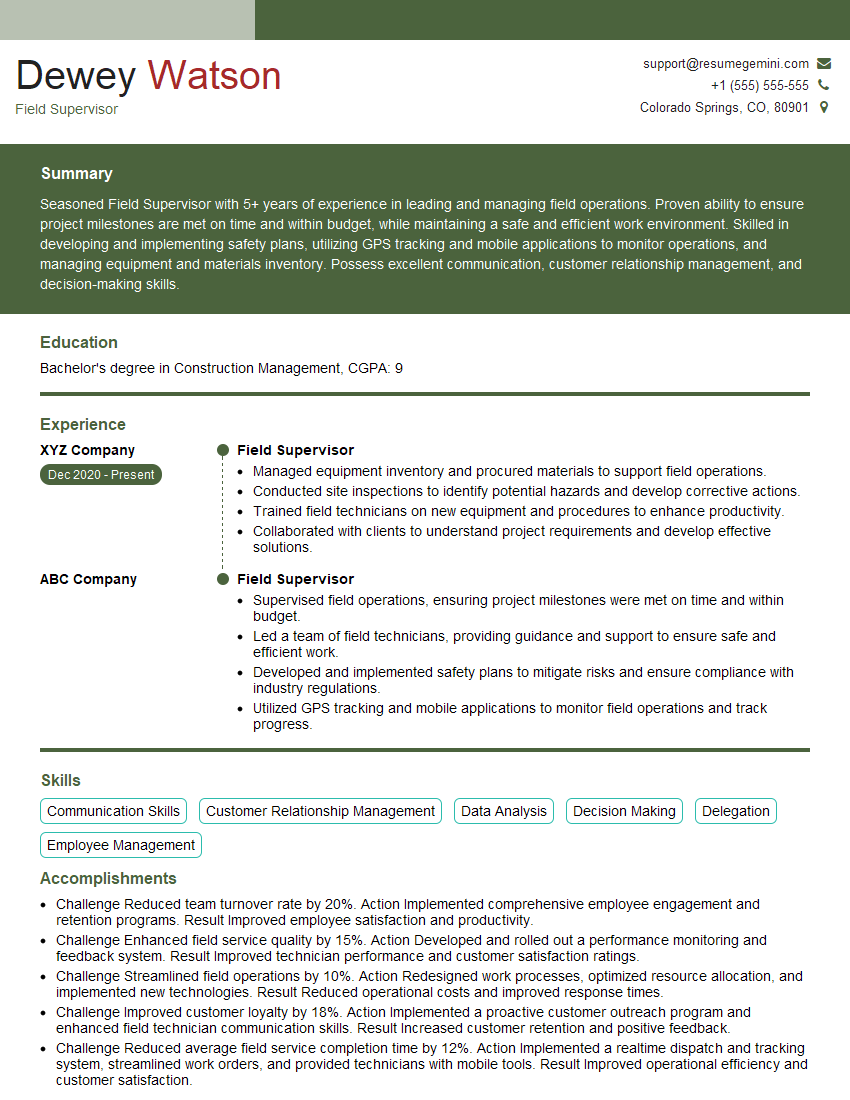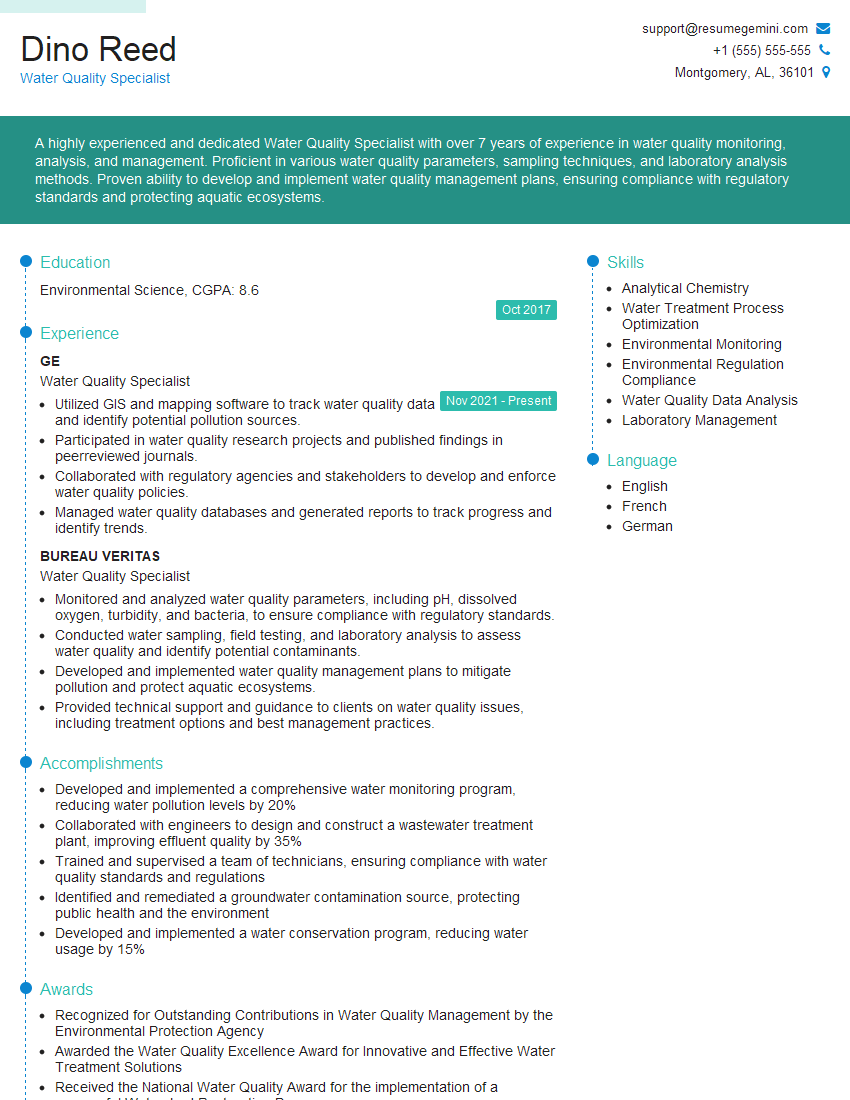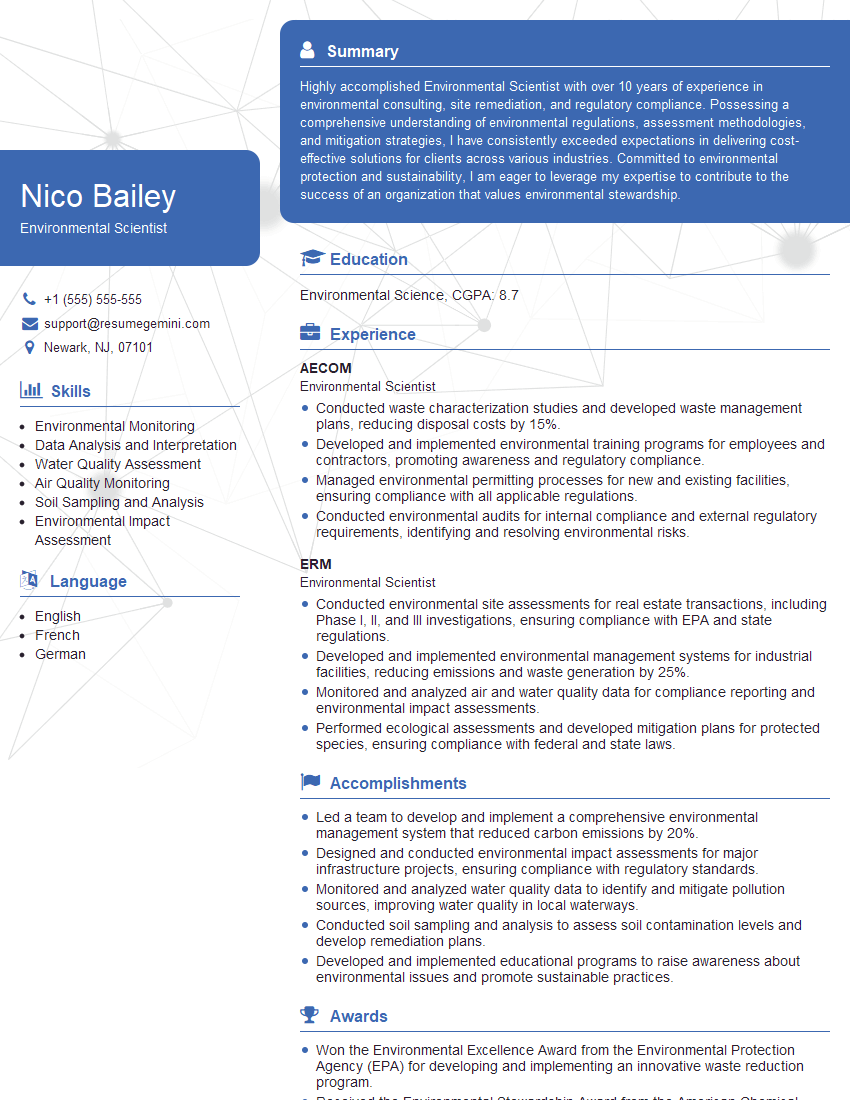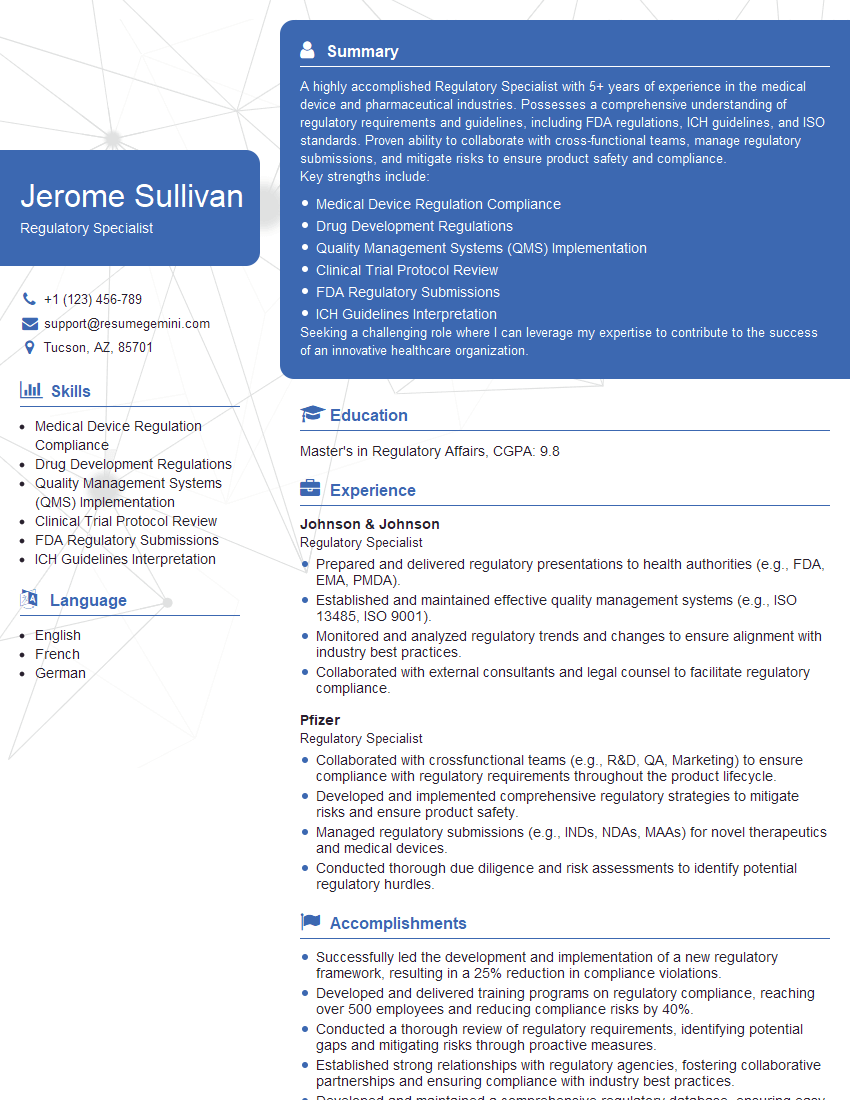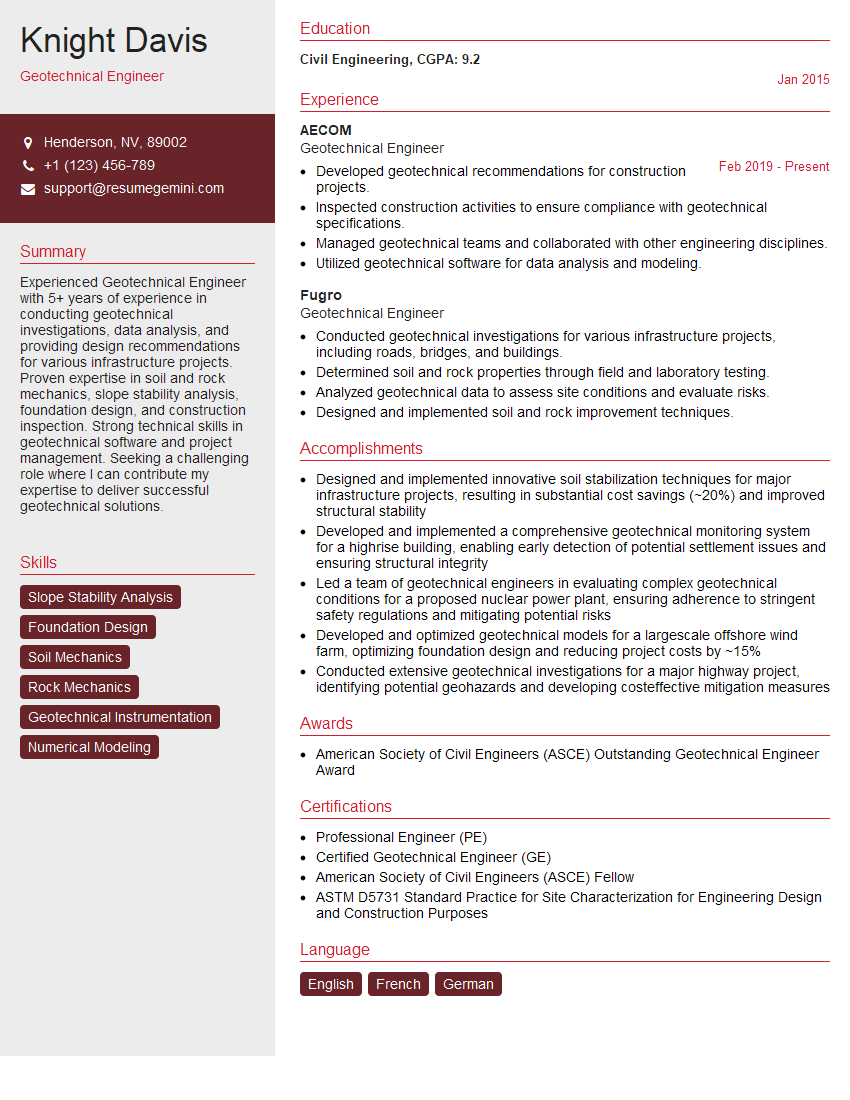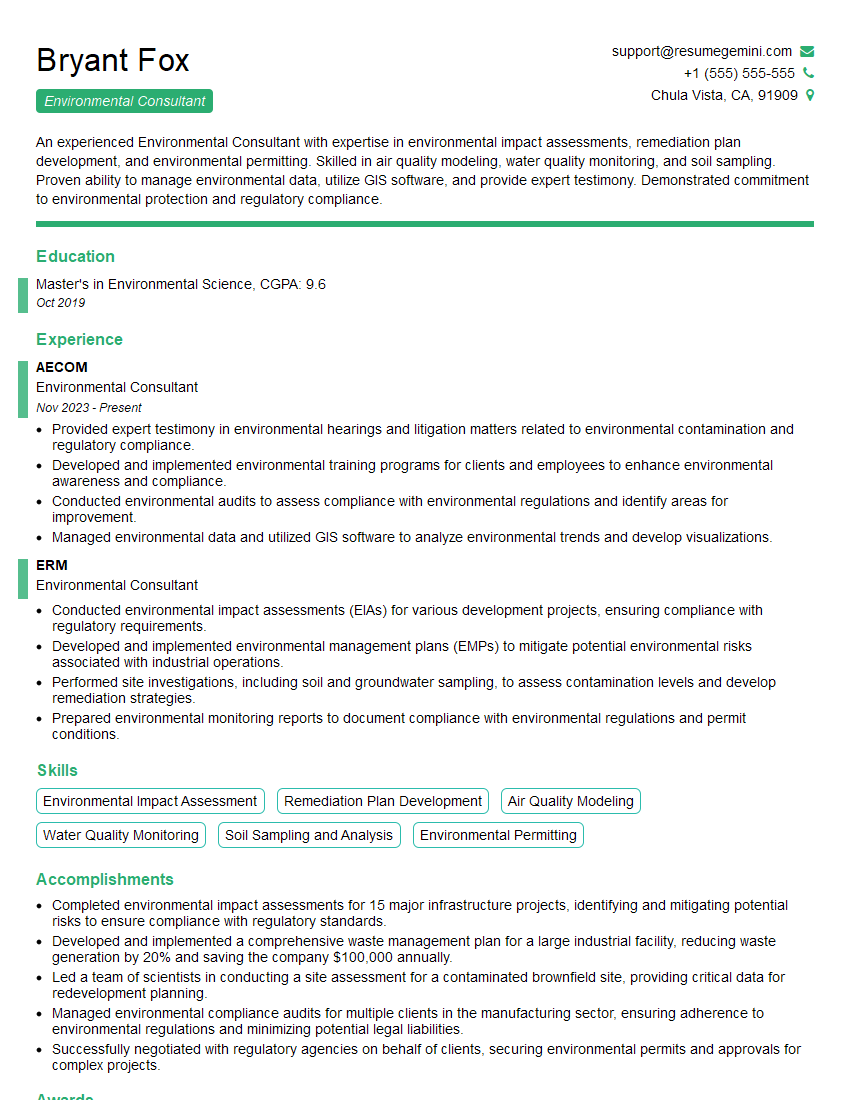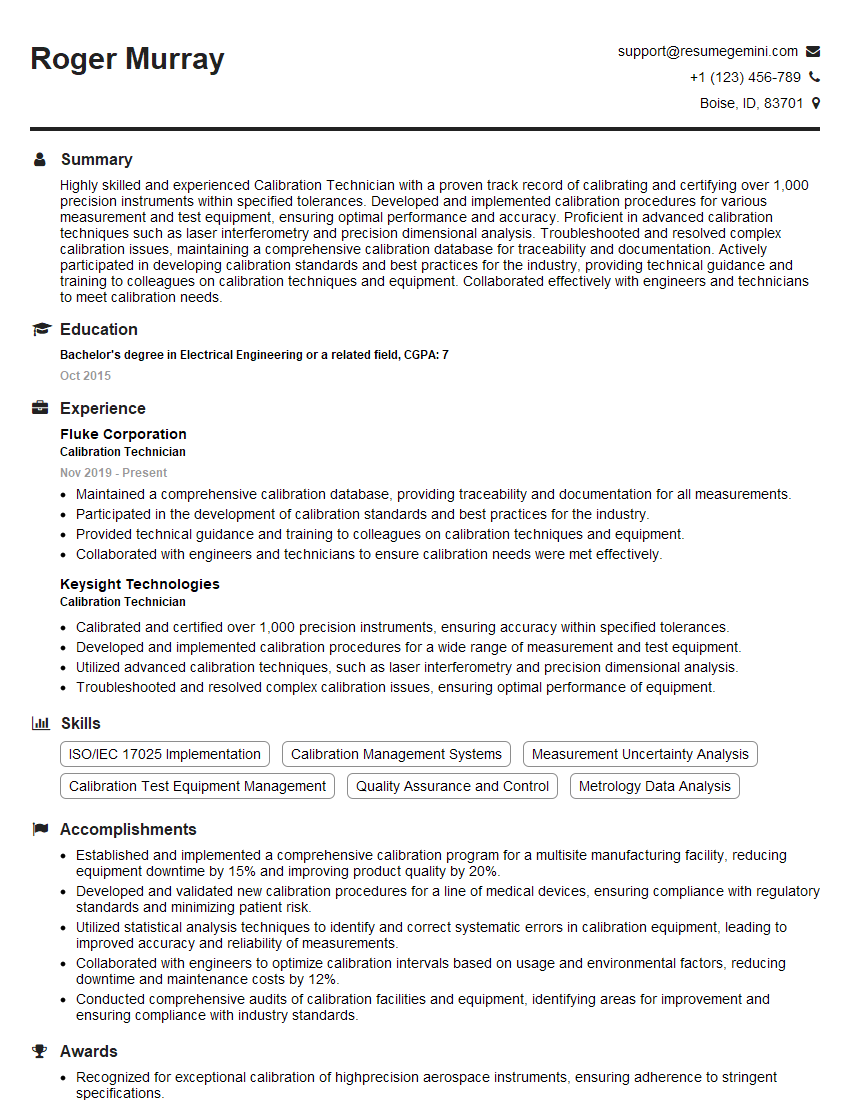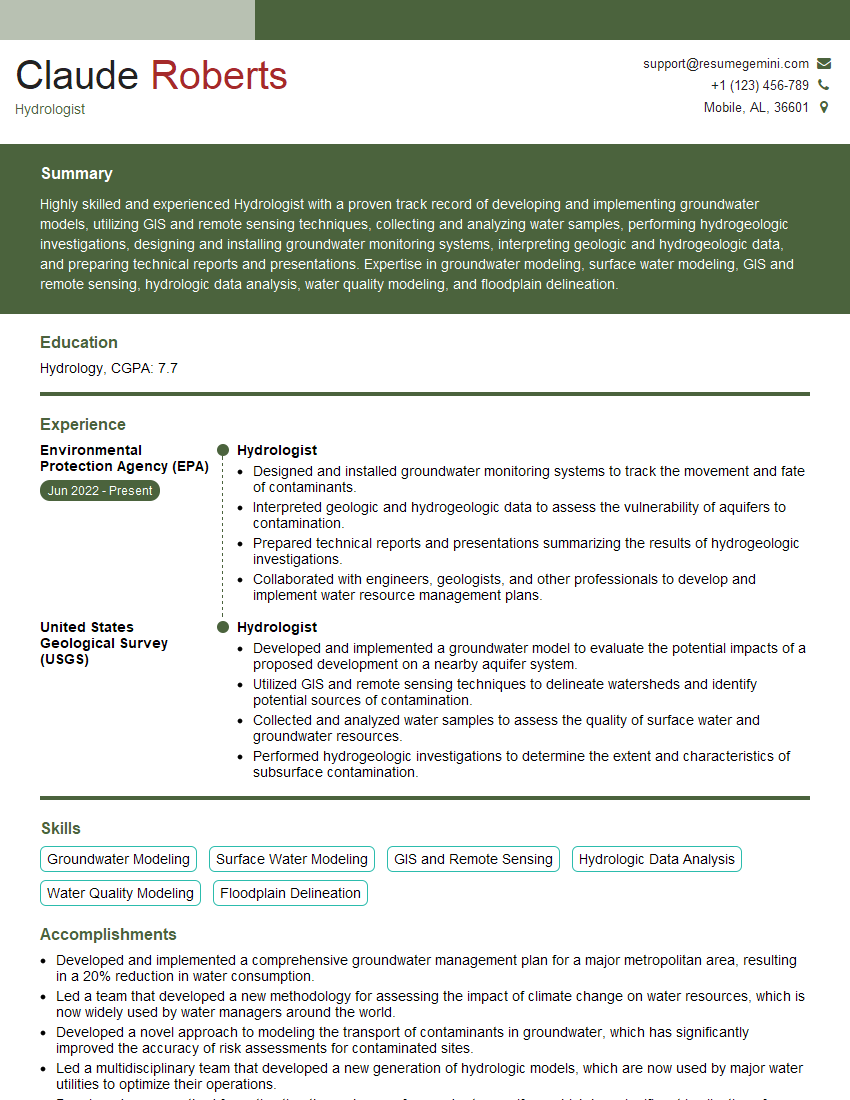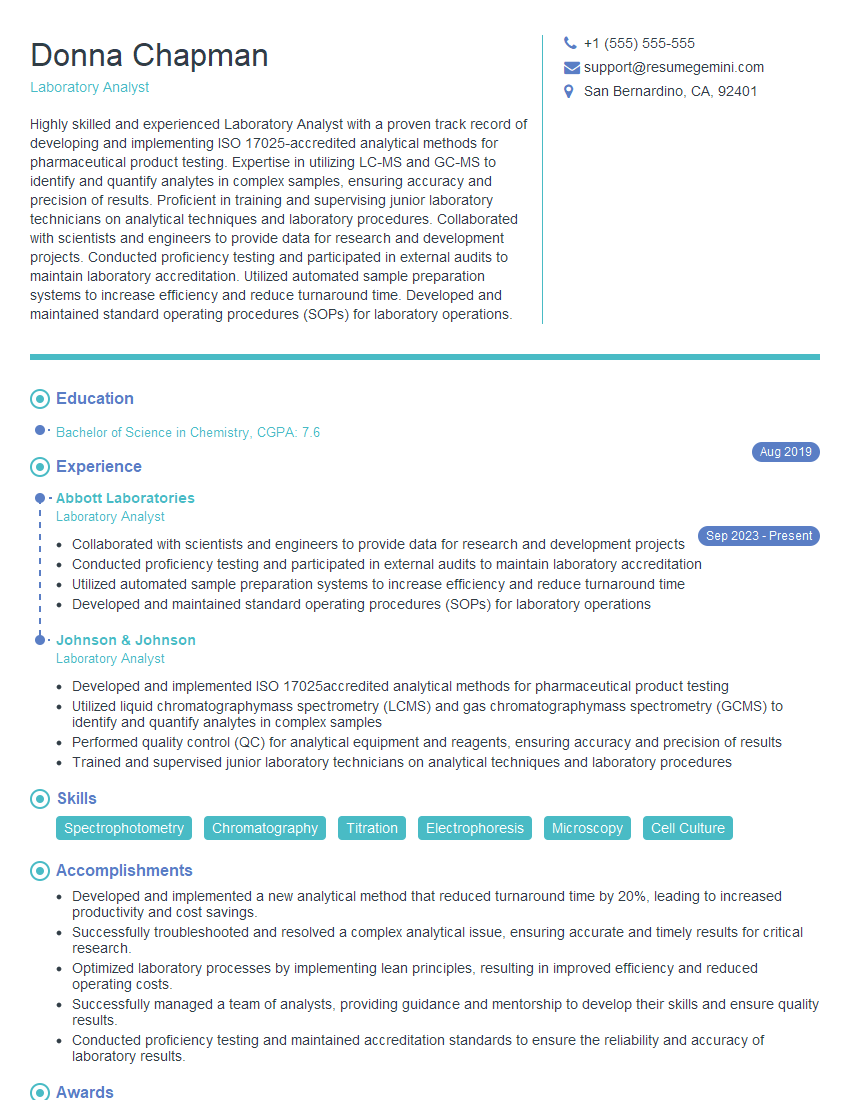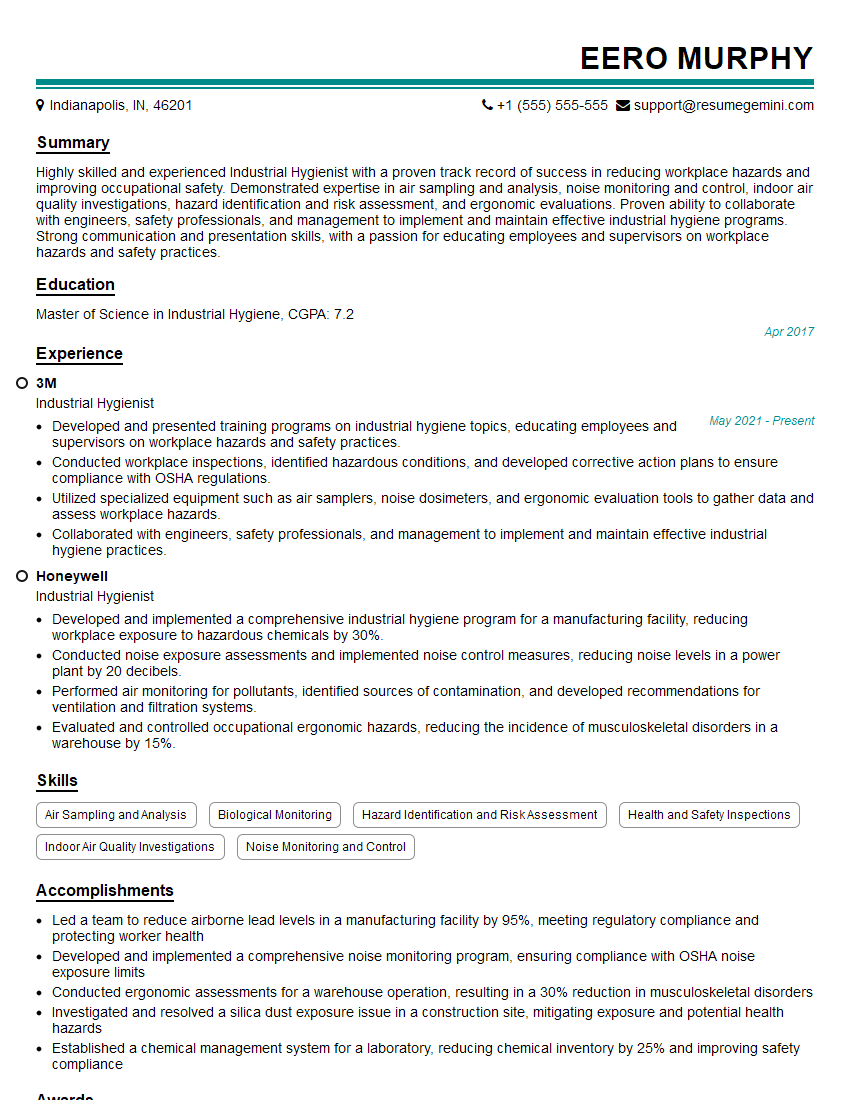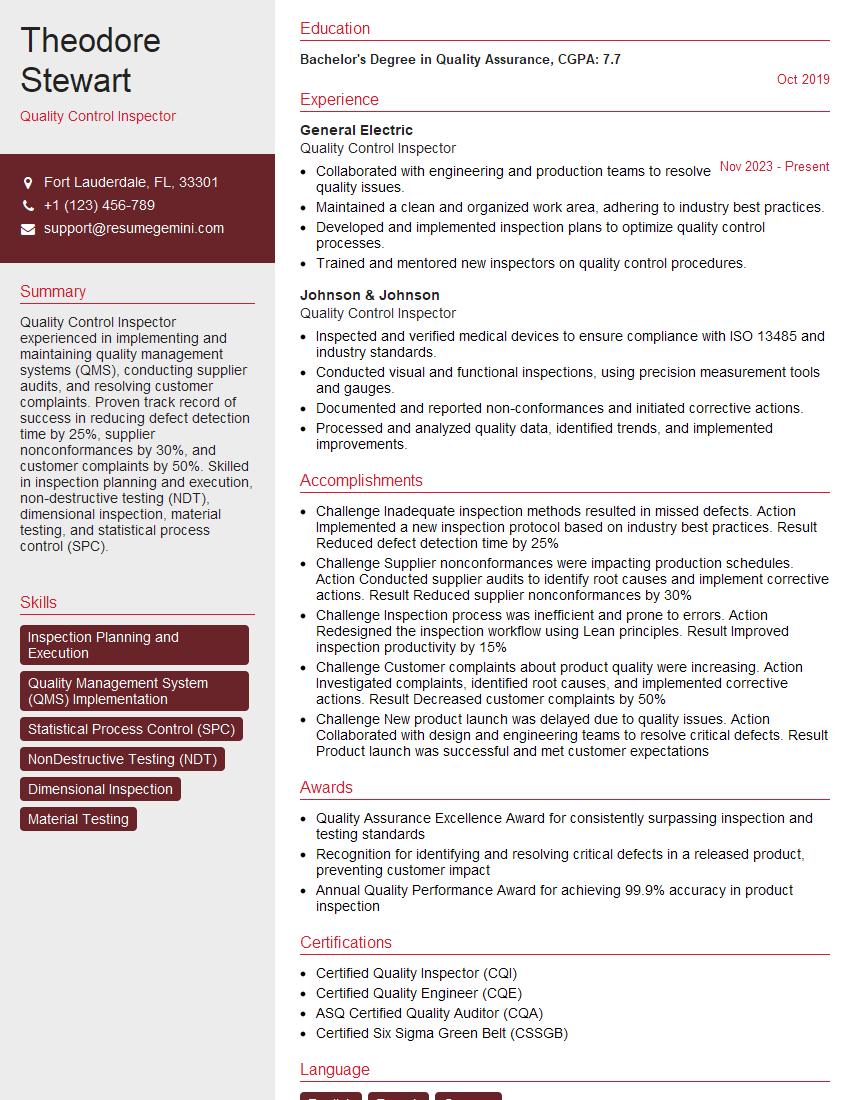Every successful interview starts with knowing what to expect. In this blog, we’ll take you through the top Sampling and Field Monitoring interview questions, breaking them down with expert tips to help you deliver impactful answers. Step into your next interview fully prepared and ready to succeed.
Questions Asked in Sampling and Field Monitoring Interview
Q 1. Explain the different types of sampling techniques and their applications.
Sampling techniques are crucial for obtaining representative data from a larger population. The choice of technique depends heavily on the nature of the population, the objective of the study, and resource constraints. Here are some common types:
- Simple Random Sampling: Each member of the population has an equal chance of being selected. Imagine drawing names out of a hat – that’s simple random sampling. It’s easy to understand and implement but might not be efficient for large or geographically dispersed populations.
- Stratified Random Sampling: The population is divided into subgroups (strata) based on relevant characteristics (e.g., age, location), and then a random sample is taken from each stratum. This ensures representation from all subgroups. For example, if studying soil contamination in an area with varied land use, stratifying by land use type (agricultural, residential, industrial) would provide a more accurate picture.
- Systematic Sampling: Selecting members at regular intervals from a ranked list. For example, selecting every 10th unit from a production line. This is simple but can be biased if the list has a cyclical pattern.
- Cluster Sampling: Dividing the population into clusters (e.g., geographic areas) and then randomly selecting clusters to sample. This is cost-effective for large populations spread over a wide area, but the results might be less precise than other methods. For instance, studying air quality across a large city might involve randomly selecting several neighborhoods (clusters) and then measuring air quality within those chosen clusters.
- Convenience Sampling: Selecting readily available members. While easy and inexpensive, this method is prone to significant bias and should generally be avoided in formal studies. For example, surveying only your friends about their opinions on a product.
The application of each technique depends on the specific context. For instance, a simple random sample might suffice for a small, homogenous population, while a stratified random sample would be more appropriate for a large, heterogeneous population to ensure representation across different subgroups.
Q 2. Describe your experience with chain-of-custody procedures.
Chain-of-custody procedures are vital for maintaining the integrity and traceability of samples from collection to analysis. My experience involves meticulously documenting every step of the process, from sample collection to its final disposal. This includes:
- Unique Sample Identification: Assigning a unique identification number to each sample. This number is consistently recorded on all associated documentation.
- Detailed Logging: Maintaining a detailed log that records the date, time, location, collector’s name, and any relevant observations for each sample.
- Secure Storage and Transport: Employing secure containers and transport methods to prevent contamination or tampering. Samples are often sealed and secured with tamper-evident seals.
- Proper Handling and Preservation: Following appropriate handling and preservation techniques to maintain sample quality. This may involve refrigeration, freezing, or the addition of preservatives.
- Transfer Documentation: Creating comprehensive transfer documentation whenever the sample is moved or handled by different individuals. Each transfer is recorded with signatures and dates.
Strict adherence to chain-of-custody procedures is essential for ensuring the legal admissibility of sampling results, especially in environmental monitoring or forensic investigations. Any breach in the chain-of-custody can compromise the integrity of the entire sampling process and potentially lead to inaccurate or unusable data.
Q 3. How do you ensure the accuracy and precision of sampling results?
Ensuring accuracy and precision in sampling requires careful planning and execution. Accuracy refers to how close the measured value is to the true value, while precision refers to the repeatability of the measurements. Here are some key strategies:
- Representative Sampling: Using appropriate sampling techniques (as discussed earlier) to ensure that the sample accurately represents the entire population.
- Calibration and Maintenance of Equipment: Regularly calibrating and maintaining all sampling and analytical equipment. This ensures reliable and consistent measurements.
- Blind or Duplicate Samples: Incorporating blind or duplicate samples into the analysis. Blind samples are analyzed without the analyst knowing their origin, helping to identify potential biases. Duplicate samples assess the precision of the analysis.
- Proper Sample Handling and Preservation: Avoiding contamination, degradation, or loss of sample integrity through appropriate storage, transport, and handling methods. For instance, using clean equipment and avoiding cross-contamination.
- Quality Control Checks: Implementing quality control checks at every stage of the process, including blank samples (containing no analyte) to identify background contamination.
- Data Validation and Verification: Rigorously reviewing and validating all data to detect and correct any outliers or errors.
For example, in water quality monitoring, using a well-mixed sample from several depths ensures representativeness. Regular calibration of the measuring instruments ensures accuracy.
Q 4. What are the common sources of error in sampling and how do you mitigate them?
Several sources of error can affect sampling results. Identifying and mitigating these errors is crucial for obtaining reliable data. Common sources include:
- Sampling Bias: This occurs when the sample doesn’t accurately represent the population, due to poor sampling design or technique. For instance, selectively choosing only easily accessible locations.
- Measurement Error: Inaccurate or imprecise measurements due to faulty equipment, poor calibration, or operator error. Regular calibration and training are crucial here.
- Contamination: Introducing extraneous substances into the sample during collection, handling, or storage. Using clean equipment and appropriate containers is essential.
- Sample Degradation: Changes in the sample’s composition due to chemical or biological processes during storage or transport. Proper preservation techniques are key.
- Human Error: Mistakes made during any stage of the sampling process, such as incorrect recording of data or mislabeling samples. Careful attention to detail and good documentation practices are vital.
Mitigation strategies involve careful planning, meticulous execution, and robust quality control procedures. This includes using appropriate sampling techniques, employing quality control samples, calibrating equipment, and training personnel. For example, implementing a robust chain-of-custody system, using clean and validated sampling equipment, and regularly training personnel on proper sampling techniques can significantly reduce human error.
Q 5. Explain your understanding of quality assurance and quality control (QA/QC) in sampling.
Quality Assurance (QA) and Quality Control (QC) are integral to ensuring the reliability and validity of sampling results. QA focuses on the overall process, while QC focuses on specific procedures and measurements to ensure quality. In sampling, QA involves developing and implementing standard operating procedures (SOPs), training personnel, selecting appropriate sampling techniques, and establishing clear documentation protocols. QC involves using techniques such as blind samples, duplicate samples, blank samples, and spike recovery tests to monitor the accuracy and precision of the sampling and analytical methods.
For example, a QA program might include a detailed SOP for soil sampling, outlining sample locations, equipment, handling procedures, and documentation requirements. A QC program might involve analyzing duplicate soil samples to assess the precision of the analytical method used to measure contaminants. Regular internal audits and external reviews also form a critical part of maintaining QA/QC standards.
Q 6. How do you handle non-conforming samples?
Non-conforming samples are those that do not meet predefined quality criteria or deviate significantly from expected values. Handling these samples requires a systematic approach:
- Investigation: First, thoroughly investigate the cause of the non-conformity. Was there an error in sampling, handling, or analysis? This investigation may involve reviewing chain-of-custody documentation, recalibrating equipment, or re-analyzing the sample.
- Documentation: Meticulously document all aspects of the non-conforming sample, including the date, time, location, and the nature of the non-conformity. The investigation findings should also be documented.
- Corrective Action: Implement corrective actions to prevent similar occurrences in the future. This might involve revising SOPs, retraining personnel, or replacing faulty equipment.
- Decision on further action: Depending on the severity of the non-conformity and its potential impact on the study’s objectives, decisions are made regarding whether to discard the sample, re-sample the location, or use alternative analytical techniques. The decision is usually documented and justified.
For example, if a soil sample is contaminated during handling, the investigation may reveal inadequate cleaning of sampling equipment. Corrective action might include implementing a stricter cleaning procedure and retraining personnel on proper cleaning techniques.
Q 7. Describe your experience with different types of field equipment (e.g., GPS, data loggers).
My experience includes extensive use of various field equipment. Here are some examples:
- GPS (Global Positioning System): Used for precise location mapping of sampling sites. This ensures accurate georeferencing of samples, which is crucial for spatial analysis and mapping of environmental data. I have experience using both handheld GPS units and integrated GPS systems within data loggers.
- Data Loggers: These devices automatically record environmental parameters like temperature, humidity, pH, and dissolved oxygen. They provide valuable contextual information for interpreting sampling results. I’m proficient in using a variety of data loggers, configuring data acquisition parameters, and downloading and processing the collected data.
- Water Quality Meters: These are used for in-situ measurements of various water quality parameters such as pH, conductivity, turbidity, and dissolved oxygen. Proficiency involves understanding calibration procedures and ensuring accurate readings.
- Soil Sampling Equipment: Experience in using various soil sampling tools, including augers, probes, and corers, depending on the soil type and sampling depth required.
- Survey Equipment: This includes equipment like total stations and levels used for accurate elevation and distance measurements, especially crucial when characterizing topography at a sampling site.
Proficiency in handling and maintaining this equipment, including calibration and troubleshooting, is essential for accurate and reliable data collection in field monitoring. This involves regular maintenance checks, calibration, and familiarity with potential malfunctions and troubleshooting techniques.
Q 8. How do you maintain and calibrate field equipment?
Maintaining and calibrating field equipment is crucial for accurate and reliable data collection. This involves a multi-step process tailored to each piece of equipment. For example, water quality meters (e.g., pH meters, conductivity meters, dissolved oxygen meters) require regular calibration using certified standard solutions. This typically involves immersing the probe in solutions of known values, adjusting the meter until it displays the correct reading, and then documenting the calibration.
- Pre-field Check: Before each use, I visually inspect all equipment for any damage or signs of wear. This includes checking cables, probes, and casing integrity.
- Calibration: Calibration is performed according to the manufacturer’s instructions and using traceable standards. Frequency depends on the instrument and usage; some require daily calibration, others may only need it weekly or monthly. I always record the calibration date, time, solutions used, and the resulting readings in a dedicated field logbook.
- Post-field Maintenance: After fieldwork, I clean all equipment thoroughly to prevent contamination. Probes are rinsed with deionized water and stored properly to extend their lifespan. Any necessary repairs are documented and scheduled.
- Preventative Maintenance: This includes regular servicing and potential repairs to prevent unexpected malfunctions during critical field operations. Scheduled maintenance ensures peak performance and reduces the risk of costly delays or errors.
For instance, during a recent soil sampling project, a malfunctioning GPS unit threatened to compromise the spatial accuracy of our data. By proactively checking its battery and functionality before the field trip and having a backup GPS, we avoided significant setbacks.
Q 9. Explain your experience with data management and analysis in the context of field monitoring.
Data management and analysis are fundamental to environmental field monitoring. My experience encompasses the entire lifecycle, from data acquisition to interpretation and reporting. I utilize various software packages (e.g., Excel, R, ArcGIS) for data organization, analysis, and visualization.
- Data Acquisition: I use standardized data sheets to ensure consistency and completeness. Real-time data is often logged directly into field data loggers or tablets and subsequently downloaded to a secure central database.
- Data Cleaning and Validation: Once data is compiled, I meticulously check for errors, outliers, and inconsistencies. This might involve visual inspection, statistical tests, or comparisons against historical data.
- Data Analysis: This stage involves applying appropriate statistical methods, such as descriptive statistics (mean, median, standard deviation), regression analysis, or time series analysis, depending on the research question. I also generate graphs and maps to visualize data trends and patterns.
- Data Reporting: I prepare clear, concise reports that summarize findings, including visualizations and tables. Reports are tailored to the intended audience (e.g., clients, regulatory agencies).
In a previous project, I used R to conduct statistical analysis on water quality data from multiple sites, identifying significant differences in pollutant levels and generating maps to visualize spatial patterns of contamination. This helped the client to prioritize remediation efforts.
Q 10. How do you interpret and report sampling results?
Interpreting and reporting sampling results requires a comprehensive understanding of both the data and the context in which it was collected. It’s not just about presenting numbers; it’s about communicating their meaning and implications.
- Data Context: I begin by considering the sampling methodology, including the sample design, location, timing, and any potential biases. This informs the interpretation of results.
- Statistical Analysis: Appropriate statistical methods are used to determine if observed differences are statistically significant or merely random variation. Confidence intervals and p-values are crucial for assessing the uncertainty associated with the results.
- Comparison to Standards: Results are compared to relevant environmental regulations (e.g., EPA water quality standards) or established benchmarks. This determines compliance status and identifies potential risks.
- Report Writing: Findings are presented clearly and concisely, using tables, graphs, and maps to enhance understanding. Limitations of the study and any uncertainties are explicitly stated.
For example, when analyzing soil sample data for heavy metals, I might report the concentrations of each metal, compare them to regulatory limits, and discuss potential sources of contamination and their ecological impacts.
Q 11. Describe your experience with various environmental regulations (e.g., EPA, OSHA).
My experience encompasses familiarity with a range of environmental regulations, primarily EPA (Environmental Protection Agency) and OSHA (Occupational Safety and Health Administration) standards. Understanding these regulations is essential for ensuring safe and compliant fieldwork.
- EPA Regulations: I’m proficient in various EPA regulations related to water quality, air quality, hazardous waste, and Superfund sites. This includes understanding specific sampling protocols, data reporting requirements, and permit applications.
- OSHA Regulations: I’m well-versed in OSHA standards concerning workplace safety, including personal protective equipment (PPE) requirements, hazard communication, and emergency response procedures. This ensures the safety of myself and my team.
- State and Local Regulations: Beyond federal regulations, I am familiar with how state and local environmental agencies might add additional layers of regulations which must also be adhered to.
For example, when conducting water sampling near a Superfund site, I ensure compliance with EPA’s specific sampling protocols to avoid contaminating the sample and compromising the results. Simultaneously, I always follow OSHA’s safety regulations related to handling potentially hazardous materials and working in potentially contaminated environments.
Q 12. How do you ensure compliance with relevant regulations and standards during sampling and monitoring?
Compliance with regulations and standards is paramount in environmental sampling and monitoring. This is achieved through rigorous planning, adherence to protocols, and thorough documentation.
- Pre-field Planning: This involves reviewing all relevant regulations and permits, developing a detailed sampling plan that outlines locations, frequencies, methods, and quality control procedures. Permits must be obtained beforehand.
- Field Procedures: Strict adherence to standardized sampling methods is crucial. Chain-of-custody procedures ensure sample integrity and traceability. All safety procedures and PPE usage is strictly followed and documented.
- Quality Control/Quality Assurance (QA/QC): Implementing QA/QC measures, such as blank samples, duplicate samples, and split samples, helps assess the accuracy and precision of the data. Results that are outside of acceptable ranges should trigger investigation and potential resampling.
- Data Reporting: Reports are formatted to meet regulatory requirements, including data tables, methodologies, and any QA/QC data. This includes proper documentation and archiving of all field data.
For instance, during a recent air quality monitoring project, I ensured compliance with EPA’s air sampling protocols, including the use of calibrated equipment, proper sample handling, and timely submission of data reports.
Q 13. Explain your understanding of statistical methods used in environmental data analysis.
Statistical methods are essential for analyzing environmental data, extracting meaningful insights, and making informed decisions. My expertise includes a range of techniques.
- Descriptive Statistics: Calculating summary statistics (mean, median, standard deviation, variance) to describe the central tendency and variability of data.
- Inferential Statistics: Using hypothesis testing (t-tests, ANOVA) to determine if differences between groups are statistically significant. Regression analysis (linear, multiple) to model relationships between variables.
- Time Series Analysis: Analyzing data collected over time to identify trends, seasonality, and patterns. This is useful for assessing changes in environmental conditions.
- Spatial Statistics: Analyzing spatially referenced data (e.g., using GIS software) to identify spatial patterns and correlations. Geostatistical techniques like kriging can be used for interpolation of data across an area.
For example, in assessing the effectiveness of a wetland restoration project, I might use time series analysis to track changes in water quality parameters over time, and spatial statistics to map the distribution of plant species to identify successful restoration areas.
Q 14. How do you select appropriate sample locations and frequency?
Selecting appropriate sample locations and frequency depends on several factors, including the study objectives, the characteristics of the environment, and the resources available. A well-designed sampling strategy is crucial for obtaining representative and reliable data.
- Study Objectives: Clearly defined objectives guide the selection of sample locations. For example, if the goal is to assess the overall water quality of a lake, a stratified random sampling approach would be suitable. If the focus is on a specific pollution source, samples should be strategically collected near that source and downstream.
- Environmental Characteristics: Factors like topography, hydrology, and land use influence the spatial variability of environmental parameters. In heterogeneous environments, more sample locations are often needed compared to more homogeneous areas.
- Sample Frequency: This depends on the temporal variability of the parameter being measured. For parameters that change rapidly (e.g., streamflow after a rainfall event), frequent sampling is necessary. For parameters that change slowly (e.g., soil properties), less frequent sampling may suffice.
- Statistical Considerations: Sample size calculations, based on desired precision and confidence levels, are essential for ensuring that sufficient data is collected to draw reliable conclusions.
In a recent project involving groundwater monitoring, I used a combination of GIS data and statistical power analysis to identify optimal well locations and sampling frequencies, ensuring we captured the spatial variability of groundwater contaminants while minimizing costs.
Q 15. Describe your experience with different types of environmental matrices (e.g., soil, water, air).
My experience spans a wide range of environmental matrices, encompassing soil, water, and air sampling. Each matrix requires a unique approach due to its distinct physical and chemical properties. For instance, soil sampling often involves using augers or corers to collect samples at various depths, carefully documenting the location and depth of each sample. Water sampling might involve collecting grab samples using bottles, or deploying automated samplers for continuous monitoring. Air sampling techniques range from passive samplers that absorb pollutants over time to active samplers that draw air through filters or impingers. In one project, I used a combination of soil core sampling, surface water sampling, and air particulate monitoring to assess the impact of a nearby industrial facility on a local ecosystem. We carefully documented the sampling locations using GPS coordinates and followed standardized protocols for each matrix to ensure data comparability and validity.
The key difference lies in the methodologies used – the tools, preservation techniques and analytes of interest all vary significantly. For example, soil samples are often dried and sieved before analysis, while water samples need to be preserved to prevent microbial growth or chemical changes, and air samples are frequently analyzed immediately or quickly preserved to prevent loss of volatile compounds.
Career Expert Tips:
- Ace those interviews! Prepare effectively by reviewing the Top 50 Most Common Interview Questions on ResumeGemini.
- Navigate your job search with confidence! Explore a wide range of Career Tips on ResumeGemini. Learn about common challenges and recommendations to overcome them.
- Craft the perfect resume! Master the Art of Resume Writing with ResumeGemini’s guide. Showcase your unique qualifications and achievements effectively.
- Don’t miss out on holiday savings! Build your dream resume with ResumeGemini’s ATS optimized templates.
Q 16. How do you prepare samples for laboratory analysis?
Sample preparation is crucial for accurate laboratory analysis. It’s a multi-step process that varies greatly depending on the matrix and the analytes of interest. For soil samples, this often involves drying, grinding, and sieving to achieve a homogenous sample for analysis. Water samples may require filtration to remove suspended solids or the addition of preservatives to prevent degradation of target analytes. For air samples, the process may involve extracting the collected pollutants from the filter media using appropriate solvents.
For example, in a project analyzing heavy metals in soil, we dried the samples at 105°C until a constant weight was achieved, then ground them to a fine powder using a mortar and pestle before analyzing them using Inductively Coupled Plasma Mass Spectrometry (ICP-MS). Proper documentation of each step, including the chain of custody, is critical to maintain sample integrity and data traceability. We always adhere to strict quality control measures throughout the preparation process to minimize contamination and error. This includes using clean equipment, working in a controlled environment, and running blank samples.
Q 17. Explain your experience with safety procedures in field work.
Safety is paramount in fieldwork. I have extensive experience following strict safety protocols, including the use of personal protective equipment (PPE), such as gloves, safety glasses, respirators, and hard hats. I’m proficient in handling hazardous materials and understand the necessary precautions for each. This includes proper disposal procedures, emergency response planning, and awareness of potential hazards in the field.
In one project involving asbestos sampling, we followed very strict safety protocols, including the use of specialized respirators, protective suits, and decontamination procedures. Regular safety training and toolbox talks were an essential part of our routine, reinforcing proper procedures and ensuring everyone remained up-to-date on best practices. We always conduct risk assessments before starting any field work and adhere to relevant occupational health and safety regulations.
Q 18. How do you handle emergencies or unexpected situations in the field?
Handling emergencies is a crucial aspect of field work. My experience includes responding to equipment malfunctions, unexpected weather conditions, and minor injuries. We always have a comprehensive emergency response plan in place, including emergency contacts, first-aid kits, and communication protocols. This plan is tailored to the specific location and potential hazards of each project.
For example, during a remote water quality monitoring project, we experienced a sudden flash flood. Using our pre-established emergency procedures, we secured our equipment, evacuated the area safely, and contacted the relevant authorities. Our thorough planning ensured a safe and swift response, minimizing any potential harm to the team or the environment. Effective communication, both within the team and with external stakeholders, is key to managing unexpected situations effectively.
Q 19. Describe your experience with different sampling protocols and methodologies.
I’m experienced in various sampling protocols and methodologies, including grab sampling, composite sampling, and time-integrated sampling. The selection of the appropriate method depends on the objectives of the study, the nature of the contaminant, and the characteristics of the environmental matrix. Grab sampling provides a snapshot of conditions at a specific time and location, while composite sampling combines multiple samples to provide a representative average. Time-integrated sampling provides information on pollutant levels over an extended period.
I’ve used stratified random sampling in projects assessing soil contamination and systematic sampling for monitoring water quality in streams. In a recent study, we used passive samplers for air quality monitoring, allowing for long-term exposure assessment. The choice of sampling method is always carefully considered and documented, ensuring that the data collected is appropriate, reliable, and directly answers the study’s research questions.
Q 20. What software and tools are you proficient in for data analysis and reporting?
I am proficient in several software packages for data analysis and reporting. This includes statistical software such as R and SPSS for data analysis, geographic information system (GIS) software like ArcGIS for spatial data visualization and analysis, and Microsoft Excel for data management and reporting. I also have experience using specialized software for analyzing specific types of data, such as those collected from air quality monitoring equipment.
For example, in a project assessing the impact of agricultural runoff on water quality, I used ArcGIS to map the spatial distribution of pollutants, R for statistical analysis of the data, and Excel for creating comprehensive reports presenting the findings. Choosing the right software is essential for efficient analysis and clear, effective communication of the results. My proficiency extends to creating visually appealing and easy-to-understand reports that effectively communicate complex scientific information to various audiences.
Q 21. How do you ensure the integrity of samples during transport and storage?
Maintaining sample integrity during transport and storage is crucial for accurate results. This involves using appropriate containers, maintaining appropriate temperatures, and minimizing exposure to light or other environmental factors that could alter sample composition. Chain of custody documentation is essential to ensure traceability and maintain the integrity of the samples. This documentation tracks the movement of samples from the field to the laboratory, including who handled the sample at each stage.
For instance, water samples are usually stored in refrigerated conditions at 4°C, whereas volatile organic compounds (VOCs) in air samples need to be kept in sealed containers at low temperatures to prevent evaporation. We also use tamper-evident seals to ensure sample integrity during transportation and storage. Following established protocols for sample handling and storage is critical for ensuring data reliability and validity. This helps maintain confidence in our findings and strengthens the overall quality of our work.
Q 22. Describe your experience with fieldwork planning and logistics.
Fieldwork planning and logistics are crucial for successful environmental monitoring. It’s akin to orchestrating a complex symphony – every instrument (person, equipment, resource) needs to be in the right place at the right time. My experience encompasses all aspects, from initial site reconnaissance and permit acquisition to scheduling personnel, securing transportation and accommodation, and managing supplies.
- Site Reconnaissance: Before any sampling begins, I meticulously assess the site, considering terrain, accessibility, potential hazards (e.g., wildlife, weather), and logistical challenges. For example, a remote wetland site might require specialized boats and GPS navigation.
- Resource Allocation: I develop detailed budgets and timelines, factoring in equipment rental, personnel costs, travel expenses, and contingency funds. This involves procuring necessary equipment, ensuring its proper calibration and maintenance, and scheduling field technicians with appropriate expertise.
- Safety Protocols: Safety is paramount. I establish and enforce comprehensive safety plans, including risk assessments, emergency procedures, and appropriate personal protective equipment (PPE).
- Data Management: I establish a robust data management system from the outset, including sample labeling, chain-of-custody documentation, and secure data storage. This ensures data integrity and traceability throughout the project.
For instance, on a recent large-scale soil sampling project, I successfully managed a team of five technicians across multiple sites, ensuring timely completion while maintaining the highest safety and quality standards. We utilized GIS mapping for efficient route planning, minimizing travel time and optimizing resource allocation.
Q 23. How do you communicate effectively with clients and stakeholders regarding sampling results?
Communicating effectively about complex sampling results requires clarity, precision, and a focus on the client’s needs. I approach this by using a multi-faceted strategy:
- Clear and Concise Reporting: I prepare comprehensive reports using non-technical language where appropriate, focusing on key findings and implications. Visual aids like graphs and maps are crucial for effectively communicating complex data.
- Tailored Communication: I adapt my communication style to the audience – a technical report for scientists might differ significantly from a presentation for a community group. I always anticipate questions and address potential concerns proactively.
- Interactive Communication: I actively encourage questions and discussions, fostering a collaborative environment. I believe in transparency and readily explain the limitations of the data and the uncertainties involved.
- Follow-up and Support: Post-report, I’m available for further clarification and to discuss any subsequent actions.
For example, when presenting findings from a groundwater contamination study to a local council, I used simplified maps and charts to show the extent of contamination, clearly explained the potential health risks, and outlined feasible remediation strategies. This led to a productive dialogue and collaborative action plan.
Q 24. Explain your experience with developing and implementing sampling plans.
Developing and implementing sampling plans requires a methodical approach based on the project objectives, the nature of the environment, and the resources available. This is a crucial step that directly impacts the reliability and validity of the findings.
- Defining Objectives: The first step is clearly defining the project goals. What questions are we trying to answer? What parameters need to be measured? This dictates the type of sampling method and the sample size.
- Sampling Design: I select appropriate sampling methods (e.g., grab sampling, composite sampling, stratified random sampling) based on the project objectives and the characteristics of the environment. The choice of sampling design heavily influences data interpretation.
- Sample Size Determination: Determining the appropriate sample size is critical. It’s a balance between achieving statistically significant results and managing costs and logistical constraints. Statistical power analyses are frequently used to guide this process.
- Quality Assurance/Quality Control (QA/QC): I incorporate QA/QC measures throughout the sampling process to ensure data accuracy and reliability. This includes using field blanks, duplicates, and spiked samples to detect and account for potential contamination or analytical errors.
For example, in a study assessing the heavy metal contamination in a river system, I developed a stratified random sampling plan, taking samples from different sections of the river (upstream, midstream, downstream) to account for variations in contamination levels. This systematic approach ensured a representative dataset.
Q 25. How do you troubleshoot equipment malfunctions in the field?
Troubleshooting equipment malfunctions in the field requires a combination of practical skills, problem-solving abilities, and resourcefulness. Preparation is key; having backup equipment and the necessary tools readily available can save precious time and ensure the integrity of the sampling process.
- Preventive Maintenance: Regular pre-field checks and maintenance are essential to prevent malfunctions. This includes calibrating instruments and checking for any signs of wear or damage.
- Systematic Troubleshooting: When a malfunction occurs, I follow a systematic approach, starting with the simplest possible causes. For example, checking batteries, connections, and power sources before considering more complex issues.
- Resourcefulness: Sometimes, creative solutions are necessary. This might involve improvising repairs using available materials or contacting technical support for remote assistance.
- Documentation: Meticulous documentation of any malfunction, including the date, time, location, the nature of the problem, and the steps taken to resolve it, is crucial. This ensures accountability and aids in future problem-solving.
During a recent field campaign, our water quality meter malfunctioned. By systematically checking the power supply and electrode connections, I quickly identified a loose cable. Repairing it allowed us to resume sampling without significant delays.
Q 26. What are the limitations of different sampling methods?
Different sampling methods have inherent limitations that must be considered when designing and interpreting results. Understanding these limitations is crucial for ensuring data validity and drawing meaningful conclusions.
- Grab Sampling: Provides a snapshot of conditions at a specific point in time and space but may not be representative of the overall population. It’s susceptible to spatial variability and temporal changes.
- Composite Sampling: Averaging multiple samples reduces variability but masks spatial heterogeneity. It’s not suitable when spatial variations are important.
- Stratified Random Sampling: Accounts for known heterogeneity but requires prior knowledge of the population’s structure. Inadequate stratification can lead to biased results.
- Systematic Sampling: Simple and efficient but susceptible to biases if the underlying pattern coincides with the sampling interval.
For example, relying solely on grab samples to assess water quality in a river could be misleading if there are significant variations in water chemistry along the river’s course. Composite sampling might obscure such important variations.
Q 27. Describe your experience with using GIS in environmental monitoring projects.
Geographic Information Systems (GIS) are indispensable tools in environmental monitoring, enhancing efficiency, accuracy, and data visualization. My experience with GIS spans various aspects of project planning and execution.
- Site Selection and Planning: GIS enables efficient site selection based on various environmental factors, land use, accessibility, and proximity to other sampling locations. It’s used to optimize sampling locations to maximize data representativeness.
- Spatial Data Analysis: GIS helps analyze spatial patterns and relationships between environmental variables. This can reveal correlations between contaminant concentrations and environmental characteristics, aiding in hypothesis formulation and problem-solving.
- Data Visualization: GIS produces visually appealing maps and charts illustrating sampling locations, contaminant distribution, and other relevant information. This facilitates effective communication of findings to clients and stakeholders.
- Data Integration: GIS integrates various data sources, such as satellite imagery, topographic maps, and environmental sensor data, creating a comprehensive spatial database for project analysis.
In a recent air quality monitoring project, I used GIS to map pollutant concentrations across a city, identify hotspots, and assess the influence of industrial activities and traffic patterns on air quality. This spatial analysis provided valuable insights for developing targeted mitigation strategies.
Q 28. How do you ensure the sustainability of your field operations?
Sustainability is a core principle that guides my field operations. It’s not just about environmental protection; it also involves resource efficiency and ethical considerations.
- Minimizing Environmental Impact: I prioritize minimizing the ecological footprint of our operations. This includes using eco-friendly transportation, reducing waste generation (proper disposal of chemicals and sampling materials), and respecting local ecosystems.
- Resource Efficiency: I strive to optimize resource utilization – for instance, employing efficient sampling techniques to minimize the number of samples needed and using durable, reusable equipment whenever possible.
- Community Engagement: I believe in engaging with local communities, respecting their perspectives, and ensuring that our activities do not negatively impact their livelihoods or well-being.
- Data Management and Archiving: Properly archiving data and metadata ensures long-term access and reuse, promoting efficiency and reducing the need for redundant data collection in the future.
For example, in a remote area project, we used electric vehicles for transport to reduce carbon emissions and engaged with local communities to obtain informed consent and share our research findings, fostering trust and mutual understanding.
Key Topics to Learn for Sampling and Field Monitoring Interview
- Sampling Techniques: Understanding various sampling methods (random, stratified, systematic, etc.), their applications, and limitations. Consider the impact of sample size and bias on data reliability.
- Field Monitoring Protocols: Mastering the development and implementation of robust field monitoring plans, including data collection procedures, quality control measures, and safety protocols. Think about how to handle unexpected situations or equipment malfunctions in the field.
- Data Analysis and Interpretation: Proficiency in analyzing collected data, identifying trends, and drawing meaningful conclusions. This includes understanding statistical concepts relevant to your field, such as descriptive statistics and hypothesis testing. Be prepared to discuss how you would present your findings.
- Regulatory Compliance: Familiarize yourself with relevant environmental regulations and safety standards related to sampling and field monitoring in your specific industry. Discuss your understanding of compliance procedures and documentation.
- Equipment Calibration and Maintenance: Demonstrate understanding of proper equipment handling, calibration techniques, and routine maintenance procedures to ensure data accuracy and reliability. Be ready to discuss troubleshooting strategies.
- Problem-Solving and Decision-Making: Prepare examples showcasing your ability to troubleshoot issues encountered during field monitoring, adapt to changing conditions, and make informed decisions based on available data.
- Reporting and Communication: Practice clearly and concisely communicating your findings through written reports, presentations, and verbal communication. Consider the audience and tailor your communication accordingly.
Next Steps
Mastering Sampling and Field Monitoring opens doors to exciting career opportunities in various industries, offering a blend of technical expertise and practical field experience. To maximize your job prospects, focus on building a strong, ATS-friendly resume that highlights your skills and accomplishments. ResumeGemini is a trusted resource that can help you craft a professional and impactful resume tailored to your specific experience. Examples of resumes tailored to Sampling and Field Monitoring are available, enabling you to showcase your qualifications effectively and land your dream role.
Explore more articles
Users Rating of Our Blogs
Share Your Experience
We value your feedback! Please rate our content and share your thoughts (optional).
What Readers Say About Our Blog
Hi, I have something for you and recorded a quick Loom video to show the kind of value I can bring to you.
Even if we don’t work together, I’m confident you’ll take away something valuable and learn a few new ideas.
Here’s the link: https://bit.ly/loom-video-daniel
Would love your thoughts after watching!
– Daniel
This was kind of a unique content I found around the specialized skills. Very helpful questions and good detailed answers.
Very Helpful blog, thank you Interviewgemini team.
